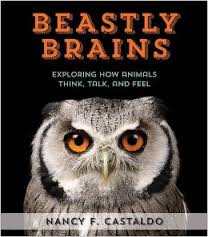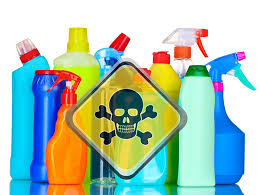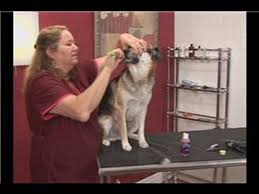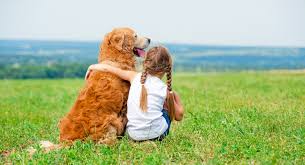Exploring How Animals, Think, Talk and Feel
Nancy Castaldo, Beastly Brains
 Nancy Castaldo authored a book with vivid photographs, first-person interviews and historical anecdotes exploring animals' ability to show empathy, communicate and develop complex social societies.
Nancy Castaldo authored a book with vivid photographs, first-person interviews and historical anecdotes exploring animals' ability to show empathy, communicate and develop complex social societies.
Years ago it was thought by many people that animals were not sentient beings and felt no pain. However, Nancy Castaldo grew up differently and she has written a book called Beastly Brains - Exploring How Animals Think, Talk and Feel. In Beastly Brains, Nancy delves into the minds of animals and explores animal empathy, communication, tool use and social societies through interviews and historical anecdotes.
Nancy grew up with parents who knew that animals were sentient beings. In fact, her mother kept books about dolphins and dolphin communication, so Nancy had quite a library to choose from when she was a kid.
However, most people still felt at that time that animals were more machine-like than people-like and that they didn't have many feelings. There were even some renegade scientists who were trying to prove otherwise, but they were having a tough time.
Dr. Debbie adds that even in the veterinary world, 30 years ago students weren't taught that animals felt pain that needed to be treated. Or that if an animal was in pain, it was a good thing and beneficial because it would keep the animal's activity restricted after surgery while they healed.
Now that we know animals have thoughts and feelings, we have learned that some animals are even capable of deception and can also feel things like jealousy, empathy and be forgiving as well.
So how can we prove that animals experience jealousy? Nancy states that it was one of her favorite experiments for the book. When she was dealing with different scientists, one group of scientists came up with the idea to test two dogs. It was a simple process where they gave one dog teats and nothing to the other dog. However, they made both dogs put their paws out repeatedly for treats. Finally, the dog that never received any treats, refused to put its paw out again. It looked at the other dog and knew they were getting treats and they weren't, so they stopped the activity. The dog knew he was being wronged.
 So is this true jealousy? Of course we are using our words, but we can figure out by that dog's actions that they are definitely feeling dissatisfied and that they had the reaction that things are not fair.
So is this true jealousy? Of course we are using our words, but we can figure out by that dog's actions that they are definitely feeling dissatisfied and that they had the reaction that things are not fair.
When researching her book, Nancy was not surprised to find out wonderful things about dolphins and elephants. However, she was surprised to find out that rats show empathy. She tells us about an experiment done on rats. The trait that was discovered was that rats felt empathy toward other rats. Rats were never one of the animals that Nancy felt would have such a complex trait.
The experiment was done using two tubes. One was filled with chocolate and another tube had a rat that was trapped inside it. The rat that was trapped was not familiar with any of the other rats used in the experiment. When a new rat was introduced, they did not know each other and the free rat was able to get the chocolate, which is a rat's favorite food. But instead of going directly to the chocolate, the free rat actually freed the trapped rat from the tube first and then it went over to the chocolate and only ate half of it, leaving the other half for the freed rat. This experiment was done many times using different rats, both in the tube and which were free, again without any of the rats knowing each other and wanting to do something for their "buddy." In all cases, the rats always freed the rat in the tube first before eating the chocolate.
So why is there no mention of cats in her book? Nancy explains that she had to include something on cats, which you will find at the end of her book where she's included a little afterword. She mentions an article that ran in the New York Times in 1876 about employing cats to deliver mail. People felt cats were intelligent and they could go around and deliver pieces of mail. This didn't work out too well, as you can imagine. But in Nancy's research on cats, she found out that there really weren't any studies she could find about a cat's cognition. She doesn't want to speculate on that, but this is something that was lacking and hopefully there are some young scientists who will take this research upon themselves. However, we do know that cats have a mind of their own!
By the end of her book, you'll think differently about the animals on this planet—maybe it's their world and we're just living in it!
Nancy Castaldo is the author of several nonfiction books for children, including Sniffer Dogs: How Dogs (and Their Noses) Save the World, Deserts, Rainforests, and River Wild. She lives in New York's Hudson Valley with her family.
Visit Website
Are Wildlife Preying on Your Pets? - Dr. Debbie
 As a veterinarian I used to think a dog fight was one of the worst things that could happen to a pet while out walking. But wildlife attacks on pets are a real and present danger. Remember the scene from the Sandra Bullock movie, The Proposal, in which Kevin, the American Eskimo puppy, is carried off by an eagle? Recently Boss, my 16-pound mixed breed dog, became a target of a flying predator not in remote Alaska, but smack dab in the heart of Las Vegas' suburbia.
As a veterinarian I used to think a dog fight was one of the worst things that could happen to a pet while out walking. But wildlife attacks on pets are a real and present danger. Remember the scene from the Sandra Bullock movie, The Proposal, in which Kevin, the American Eskimo puppy, is carried off by an eagle? Recently Boss, my 16-pound mixed breed dog, became a target of a flying predator not in remote Alaska, but smack dab in the heart of Las Vegas' suburbia.
During a walk at our community park before sunrise, I heard a loud beating of wings as a Great Horned Owl swooped down over Boss, my 16-pound terrier mix. My other dog Nikki, a Bouvier des Flanders, ran up to Boss and the owl flew off and retreated to a light pole and sat studying Boss' movements. Fearing the owl appeared ready for a second try, I snatched Boss in my arms and hightailed it out of there.
Boss was lucky to have the deterrent of an eighty pound doggie sister nearby. But not all pets get off so lucky when wildlife predators are concerned. Outdoor cats and dogs may disappear during the night falling victim to a suspected coyote attack. Small pets under 20-pounds can be whisked off by birds of prey. Stories of wildlife attacks such as these occur all the time and the internet reads of horrific stories by owners who lose their small pets to wildlife.
What Animals To Watch For?
Coyotes are found not only in rural areas, but also thrive in metropolitan areas. Mountain lion and bobcats are other predators that are a concern for homeowners in more remote areas or along the outskirts of towns. Birds of prey such as owls, hawks, and eagles are very capable hunters, are protective of nesting sites and can easily carry off small animals two to three times their body weight.
What Can You Do?
Be especially watchful near parks, golf courses or near natural paths that wildlife use as travel corridors, such as flood channels or washes. Remember that an abundance of prey animals like wild bunnies in your community means prime hunting grounds for urban predators.
Don't leave your pets out at night unattended and preferably escort them using a leash. Wildlife rarely will approach a small pet if it is near a human or other larger animals.
 Install motion activated lights on property.
Install motion activated lights on property.
Ensure all dog runs have a roof or fencing above to prevent predators from jumping over enclosure walls.
Building high fences and walls may seem like a solution, but predators can easily jump over these. Consider coyote fencing - a style of fencing that may help deter a predator from entering your backyard. Visit Coyote Roller - an ingenious and humane method to prevent a coyotes and other dogs from being able to get over the top of fence with rolling metal bars installed along fence line.
Avoid Attracting Prey Animals
Take steps to make your yard less attractive to nuisance animals like possums and raccoons as well as potential prey animals. Remove wildlife feeding stations like bird feeders. Secure garbage cans. Keep brush trimmed and landscape maintained to avoid hiding sites for animals. Avoid fruit producing trees that serve as food sources. Feed pets indoors to avoid leaving a food source outside for mice, rats or other critters.
Any Other Tools to Protect Pets?
Check out the Raptor Shield, a lightweight protective cape made of polycarbonate plastic - the same compound used in bulletproof shields. This dog vest product was developed to stop a bird of prey's sharp talons from penetrating into small pets.
 What To Do If Your Pet Is Targeted By Wildlife?
What To Do If Your Pet Is Targeted By Wildlife?
Make noise, wave arms and throw rocks to drive away animals. Carry a whistle, air horn or pepper spray for defense. Remember that some species of raptors are protected species and harassing or injuring them can result in fines.
Preventative efforts are far more useful than any steps you can take to spook away a predator after an attack occurs. Speak to your neighbors and share information if you spot coyotes or birds of prey in your neighborhood.
Don't get me wrong - I wish no ill will on nature's most efficient predators. I still find those soaring raptors breathtaking and I am awed by the coyote's adaptability, but from now on I'll prefer to watch nature's animal wonders with my little terrier guy safely seated on my lap.
Featured veterinarian known as "Dr. Debbie" on national pet radio program, Animal Radio. Ebook author of "Yorkshire Terriers: How to Be Your Dog's Best Friend"; "Pugs: How to Be Your Dog's Best Friend"; "Mini Schnauzers: How to Be Your Dog's Best Friend"; and "Shih Tzu: How to Be Your Dog's Best Friend." Dr. Debbie's books.
Visit Website
5 Ways We're Loving Our Pets To Death
Robert Semrow, Listomania
 Many of us reward our loving pets with a gift or two. Maybe this year we should be looking at our overall approach to how we treat our pets and realize that our love, while deserved and well intentioned, can actually be hurting our pets in the long run.
Many of us reward our loving pets with a gift or two. Maybe this year we should be looking at our overall approach to how we treat our pets and realize that our love, while deserved and well intentioned, can actually be hurting our pets in the long run.
To begin with, I'd argue that our love for our pets is the biggest cause for the rise in obesity in pets. It's an epidemic and is dramatically impacting the health and longevity of our pets. It isn't just the ingredients that some treats have, it's the fact that we love our pets, our pet's love treats and we love to see them happy. So what to do? The most important thing you can do is to remember that a treat is not a meal. It is in addition to the meal. So if you are giving a number of treats to your pets, keep track and reduce some of their actual meal accordingly. An occasional splurge day isn't the problem; it's the constant daily-added treats that add weight. Even just a few a days of many treats can add up to big problems over a month, let a lone a year. So treat, but treat responsibly.
Next is driving in the car without your pet being restrained. I know it's cute to see a happy dog with his head sticking out the window. The problem is that any sudden stop and that beautiful pet of yours becomes a flying projectile that can be harmed and cause harm. And for you lap sitters out there, your pet doesn't understand that you need to focus on driving. I know you love them, but loving them means being responsible for them and in this situation making sure they are securely retrained for their safety, your safety and the safety of others.
Then there is the dreaded vet exam. They hide or they pretend they are asleep just to avoid the stress of heading to the vet. Oh wait; maybe that's what I do. I know my pets don't love going to the vet, but that's my problem. I need to make it a more enjoyable experience and help them have a better experience. Your vet needs to see your pets at least once a year and you need to make that happen. So much can change in a year, let alone the multiple years' scale we use for dogs and cats.
 Next up is not correcting a behavior because you don't want to be the mean one. Bad behaviors can be a sign of many things, boredom, frustration, illness, not knowing better and more. Correcting or redirecting a behavior is important for your pet and yourself.
Next up is not correcting a behavior because you don't want to be the mean one. Bad behaviors can be a sign of many things, boredom, frustration, illness, not knowing better and more. Correcting or redirecting a behavior is important for your pet and yourself.
Finally, and this one is easy to miss, cleaning supplies need to be pet safe. It's important that you clean, but more importantly that you clean with products that are safe and won't harm your pets. Bedding, bowls and more need to be cleaned with products that say they are pet safe. Just because it's natural or green does not mean that it is pet safe.
We love our pets and our pets deserve love and care. Just remember that part of loving them is also being responsible for them and their safety.
Share your ways you love your pets on our Animal Radio Facebook Page.
Visit Website
 The Dogfather's Grooming Tip with Joey Villani
The Dogfather's Grooming Tip with Joey Villani
Groomers Shouldn't Be Doing Dental Work
Joey has noticed that more and more professional groomers are adding dentistry to their services. This is something that Joey is totally against. A grooming saloon is for hair. Plus, saloons usually don't have the proper equipment and groomers are not professionally trained to perform these procedures.
What happens is they scrape the teeth, leaving them very porous. When scraped teeth are not then properly polished, the staining will come back and decay will quickly set in. It is better to leave the teeth alone than to do this. It is also illegal in some states for professional groomers to perform any kind of dentistry on pets.
You should always have your pet's teeth cleaned and checked out by a licensed veterinarian. They have the tools and have gone to school to learn how to do it properly.
However, if your groomer is just going to brush your dog's teeth, that is okay. The only problem with this is that if you are not going to follow up and brush your dog's teeth on a regular basis at home, there is really no point. This would be like you only brushing your teeth every time you got your hair cut.
 Joey had a client once who brought her two pugs in to be groomed. She also asked him about their bad breath because they had a terrible mouth odor. Joey checked out their teeth, and says you too should check your pet's teeth on a regular basis. It turns out these dogs were big lickers and they had an abundance of hair that was wrapped in their teeth and stuck in their gums. He then took a cotton swab with a little bit of liquid toothpaste made for dogs and removed about a tablespoon of hair from their teeth. It turns out the teeth were okay and just removing the hair made the odor go away. Left unchecked, not only will it smell, but trapped hair can also become infected and lead to tooth decay or something worse.
Joey had a client once who brought her two pugs in to be groomed. She also asked him about their bad breath because they had a terrible mouth odor. Joey checked out their teeth, and says you too should check your pet's teeth on a regular basis. It turns out these dogs were big lickers and they had an abundance of hair that was wrapped in their teeth and stuck in their gums. He then took a cotton swab with a little bit of liquid toothpaste made for dogs and removed about a tablespoon of hair from their teeth. It turns out the teeth were okay and just removing the hair made the odor go away. Left unchecked, not only will it smell, but trapped hair can also become infected and lead to tooth decay or something worse.
If you don't want to, or can't check your dog's teeth, ask your professional groomer to check them out. But leave all dentistry to the professionals.
Animal Radio News - Lori Brooks
 "Third-Hand" Smoke Harms Pets
"Third-Hand" Smoke Harms Pets
The FDA has a warning for pet owners who smoke, saying it's not just second-hand smoke that's harmful to pets. Animals are also at risk for being exposed to third-hand smoke, which includes the residue that lingers on skin, clothes, carpets and other household items that ends up on their fur. Obviously most animals groom themselves, meaning that the residue is getting transferred from the floor, couch or your hand to their fur and is then ingested. Certain dog breeds are already at an increased risk for nose and lung cancer and cats living in the homes of people who smoke more than a pack a day have triple the risk of lymphoma, according to the FDA, which also says that smoking can endanger birds, guinea pigs and even fish.
Police Given Okay To Shoot Dogs
In a shocking and controversial decision, a Michigan Federal Court granted police the right to shoot a dog that moves or barks at them when they are inside a home. The decision stems from a 2013 incident in Battle Creek, Michigan, where police shot and killed two dogs while executing a search warrant looking for drugs inside a couple's house. The couple says that police acted unreasonably when they fatally shot the pit bulls during the home search. The officers who were involved said that at least one of the dogs "lunged" at them and they could not safely get out of the basement of the home with the dogs there. The Fourth Circuit Court decided that the officers acted reasonably. As the ruling notes, we quote, "Are not saying the officers' responses in these cases were the best possible responses. We are only saying that under the circumstances existing at the time the officers took the actions, and in light of the facts known by the officers, their actions were objectively reasonable.... Even dog owners can find their pets to be unpredictable at times."
 Skin Cream Kills Dogs
Skin Cream Kills Dogs
A skin cancer cream that is usually used to cure and prevent skin cancer has killed at least five dogs after they accidentally swallowed it. The Food and Drug Administration is warning pet owners to keep the prescription cream out of reach from pets. It is called fluorouracil and is sold under the brand names Fluoroplex, Efudex and Carac. In one case, two dogs were playing with a tube when one dog punctured the tube before the owner could get it away from them. Two hours later, the dog that punctured the tube began vomiting and having seizures. It died a few hours later. In another case, a dog found his owners fluorouracil tube of cream and ingested some of it. The owner then realized that the dog had eaten some of the medication and rushed it to the vet where it had to be euthanized. The FDA is warning pet owners who are using the medication to be extra careful if they have pets, because even minuscule amounts of fluorouracil can be deadly to animals. Although there are no reported cases of cats ingesting the cream, they could also be at risk. Also remember, if someone uses it then touches their cat, the cat can accidentally ingest the medication while grooming itself. The FDA advises pet owners to keep the medication in a place that's out of reach for pets. You also need to clean clothing and surfaces that may retain traces of the medication and to ask your health care provider on the right way to cover the treated area. If pets show symptoms of exposure, pet owners are advised to consult a veterinarian immediately.
 Kids Don' Need Siblings - Just a Pet!
Kids Don' Need Siblings - Just a Pet!
According to a study from the University of Cambridge, children get more satisfaction from the relationships they have with their pets than with their brothers and sisters. The research also found that many children get along with their pets better than their siblings. That's not the best news for parents with many children, but the study does seem to speak to the importance that a pet can play in childhood development while helping kids foster social skills. Earlier studies have often found that boys report stronger relationships with their pets than girls do, but this study found exactly the opposite to be true. While boys and girls were equally satisfied with their pets, girls reported more companionship and conflict with their pet than boys and girls talks more to their pets.
 Listen to the entire Podcast of this show (#1109)
Listen to the entire Podcast of this show (#1109)





